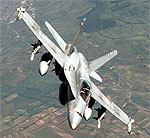From Libyan airspace, civilians hard to define
 For the aviators flying over Libya and deciding whether to press the button, the three-day-old U.S. military-led mission over Libya can be hard to define.
For the aviators flying over Libya and deciding whether to press the button, the three-day-old U.S. military-led mission over Libya can be hard to define.
“Sometimes these are situations that brief much better at a headquarters than they do in the cockpit of an aircraft,” said Gen. Carter Ham, the commander of U.S. Africa Command, which includes Libya.
The aircrews flying over Libya have instructions to protect civilians, not to support the rebel forces fighting Libyan leader Moammar Gadhafi, Ham said in a briefing Monday with reporters from his headquarters in Germany.
But it’s often unclear who is a civilian and who is a rebel.
“It’s a very problematic situation,” Ham said. “Many in the opposition truly are civilians and they are trying to protect their homes and their families and their businesses. And in doing that, some … have taken up arms. But they are basically civilians.”
On the other hand, “there are also those in the opposition that have armored vehicles and they have heavy weapons … and those parts of the opposition, I would argue, are no longer covered under that ‘protect civilians’ clause,” Ham said.
“It’s not a clear distinction because we are not talking about a regular military force,” he said.
Unlike the populist uprisings in Egypt and Tunisia, the opposition in Libya includes well-armed splinter factions of the Libyan military who reportedly have armored vehicles, heavy artillery and other military equipment.
U.S. aircraft involved in the mission include U.S-based Air Force B-2s, Europe-based F-15s and F-16s and Marine AV-8 Harriers from the amphibious assault ship Kearsarge in the Mediterranean Sea. Among the initial 60 aircraft operating over Libya, about half were U.S. military aircraft and half from other nations, Ham said.
U.S. military officials are leading the mission but hope to transfer command and control to other coalition members soon. However, it’s unclear who or what organization will take over. A NATO command could take control, but some member nations are ambivalent about the strikes. A coalition of France and Britain is another option under discussion.
“Of course the first thing that’s got to happen is the identification of what that organization is,” Ham said. He declined to set a date for the transition.
“We are ready to begin that process immediately as soon as that follow-on headquarters is identified, and we will accomplish that transition as expeditiously as we possibly can,” Ham said.
However, he added, “it’s not so simple as having a handshake someplace and saying, ‘Here, now you’re in charge.’ ”
Ham said the mission does not involve attacking Gadhafi. “I could see accomplishing the military mission that has been assigned to me and the current leader will remain the current leader,” he said. “Is that ideal? I don’t think anyone would say that is ideal, but I could envision that as a possible situation at least for the current mission that I have.”